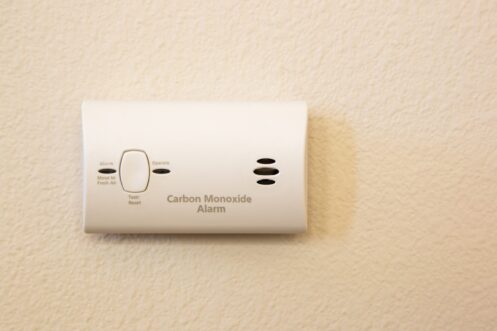
Although you’ve almost certainly heard how dangerous carbon monoxide can be, you might not know that there is an increased risk of carbon monoxide poisoning during the winter. Carbon monoxide is a colorless, odorless gas that is produced when carbon-containing fuels such as gasoline, natural gas, wood, or charcoal burn incompletely due to a lack of oxygen. It’s often emitted by things like combustion engines and incinerators, but it can also be produced by a faulty HVAC system. It is fatal in large doses, and since it’s both colorless and odorless, it is often known as the “silent killer.”
Having carbon monoxide detectors in your home will help protect you and your family from carbon monoxide poisoning, but you should also have your home regularly tested for carbon monoxide leaks by an AC and furnace service professional. Here are a couple of reasons why this should be done during the winter or before the winter.
Relying More on Your Furnace and Other Appliances
It gets cold during the winter even in San Antonio, and it stands to reason that you’re more likely to rely on your furnace to keep warm in your home. This is all well and good if your furnace is in good shape, but we’ve previously established that a faulty furnace can produce an abundance of carbon monoxide in your home. This usually happens due to a cracked heat exchanger. The heat exchanger is the part of your furnace that surrounds the natural gas as it burns inside your furnace. As it heats up, it transfers heat energy to the rest of your HVAC system so warm air can be distributed throughout your house. If the heat exchanger is cracked, the carbon monoxide produced by the burning natural gas can escape into your home.
Carbon monoxide can also be produced by kerosene heaters, stoves, ovens, and any other appliances that rely on burning some kind of fuel to produce heat, especially if those appliances are damaged or poorly maintained.
The reason why this is a bigger deal during the winter is because that is when you are far more likely to use your furnace or space heaters to stay warm. If your furnace has a cracked heat exchanger and is leaking carbon monoxide, continued use on cold days will only expose you to higher levels of carbon monoxide.
Reduced Ventilation
Since it’s colder during the winter, you are far less likely to have your windows open in your home. While there is more to ventilating your home than simply opening a few windows, your windows do play a role. Not only are your windows more likely to stay closed during the winter, but they might also be sealed with weatherstripping. This is a good way to keep your home insulated and feeling comfortable, but it could make things worse if you have a carbon monoxide leak.
Preventing Carbon Monoxide Poisoning
While there is no way to detect carbon monoxide on your own, carbon monoxide poisoning does have symptoms that you can look for, such as:
- Shortness of breath
- Nausea
- Headaches
- Dizziness
- Light-headedness
- Confusion
- Disorientation
- Overall weakness
If you or anyone in your home starts experiencing these symptoms or if your carbon monoxide alarm goes off, evacuate your home immediately and call 911. Once you are safe, you can call to have your home tested for carbon monoxide leaks and have the problem repaired by a qualified HVAC contractor.
As for precautions that you can take, your best course of action is to have your AC and heating system inspected and serviced at least once a year. This inspection should include having your home tested for carbon monoxide leaks. Other precautions include never starting your car and letting it run in a closed garage, not heating your home with a gas oven, and never running a generator indoors. Make sure that your kitchen is ventilated properly as you will likely be using your stove and oven more often during the winter.
Call MD Air Conditioning & Heating for Assistance
If your furnace needs a tune-up or you need any other HVAC services, MD Air Conditioning & Heating will be happy to assist you. We are a locally owned and operated HVAC company servicing San Antonio, TX and the surrounding areas, and we always strive to be the most reliable heating and cooling contractor in the region. All of our technicians are state-licensed, and we offer a 100% guarantee whether we’re making repairs on a faulty furnace or installing a new air conditioner.
To learn more about our heating and cooling services or to receive a free quote, contact MD Air Conditioning & Heating in San Antonio today.
Tags: furnace tune ups, heating tips
